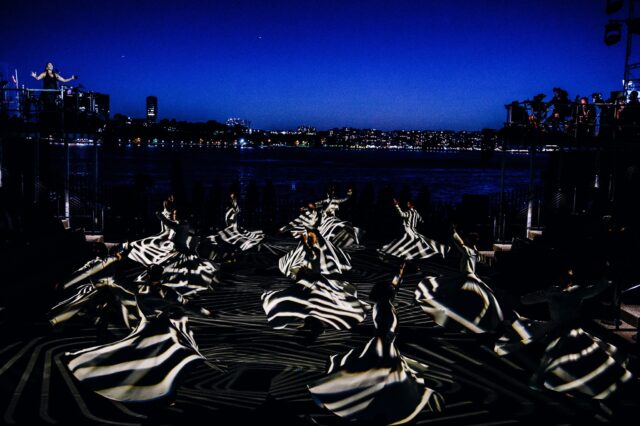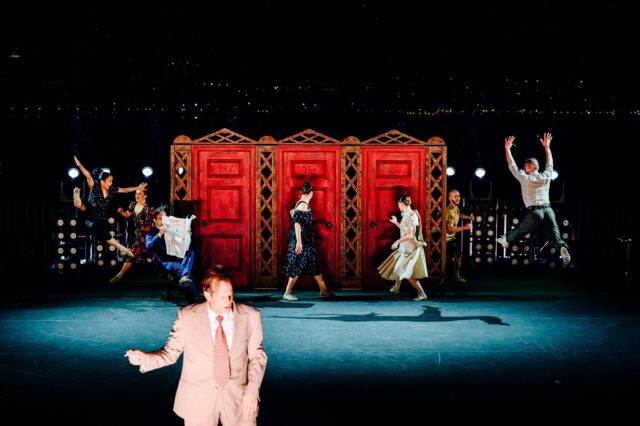
Whirling dervishes light up Little Island in Twyla Tharp’s How Long Blues (photo by Nina Westervelt)
HOW LONG BLUES
The Amph, Little Island
Pier 55, Hudson River Park at West Thirteenth St.
Wednesday – Sunday through June 23, $25
www.littleislandtickets.com
www.twylatharp.org
On opening night of Twyla Tharp’s How Long Blues at the 680-seat outdoor Amph on Little Island, a storm threatened. At one point, as rain began to fall, a dancer slipped on the stage, and project funder Barry Diller looked over at Tharp and wondered if they should stop the performance. Tharp shook her head, and the show went on, the weather adding a touch of magic and menace.
Little Island has hosted live music, dance, and storytelling the past several summers, but How Long Blues is the first work specifically commissioned for the sculpted oasis on the Hudson River, near the Whitney, kicking off a season of such pieces. The eighty-two-year-old Tharp incorporates her signature melding of contemporary movement and classical ballet into a rough-hewn narrative inspired by Albert Camus’s 1947 novel The Plague, a parable about fascism set against an epidemic. The book begins, “The unusual events described in this chronicle occurred in 194– at Oran. Everyone agreed that, considering their somewhat extraordinary character, they were out of place there.” How Long Blues might be a bumpy ride, but it feels like it belongs in the space, particularly as the wind swept through and the percussion was mistaken for thunder.
The sixty-minute premiere features two-time Tony winner Michael Cerveris (Fun Home, Assassins) as Nobel Prize–winning French philosopher and playwright Jean-Paul Sartre (Being and Nothingness, Existentialism and Humanism) and longtime ABT and Tharp dancer and choreographer John Selya as Camus (The Stranger, The Rebel); the two were close friends — Camus at one point was going to star in and/or direct Sartre’s play No Exit — until ideological differences over communism and freedom led to a public falling out. None of that is apparent in How Long Blues.
Cerveris spends most of the show walking around Santo Loquasto’s set with a copy of Le Figaro, smoking a pipe, wearing a headset, and watching the action, occasionally sitting on one of the audience benches. Selya, in a dapper suit, wanders back and forth across the stage, pursuing nearly every woman after one of his lovers jumps into the Hudson. Camus was a well-known philanderer who cheated on his wives; his second spouse, pianist and mathematician Francine Faure, was hospitalized with depression and attempted suicide.

How Long Blues features surprising props and set changes (photo by Nina Westervelt)
The score, by thirteen-time Grammy-winning singer-songwriter, guitarist, and producer T Bone Burnett and composer, musician, and violinist David Mansfield, who were both part of Bob Dylan’s Rolling Thunder Revue in the mid-’70s, is a curious thing. Much of it is prerecorded even though there is a seven-piece band (John Bailey on trumpet and fugelhorn, Justin Goldner on guitar, tenor banjo, and bass, Wayne Goodman on trombone, Mark Lopeman on sax and clarinet, Jay Rattman on saxophone, George Rush on bass and tuba, and Paul Wells on percussion) in addition to underutilized vocalist Andromeda Turre, all of whom are placed in two balconies at the west corners of the space. The song selections are also not particularly illuminating.
An unhoused man plays “My Way” on a trumpet. There’s an excerpt of the Sound of Feeling’s cover of Donovan’s “Hurdy Gurdy Man,” along with Mardi Gras Indian group the Wild Tchoupitoulas’s “Meet de Boys on the Battlefront” and “Brother John” and music by Jelly Roll Morton, Muddy Waters, Cab Calloway, and Count Basie. Cerveris eventually puts the headset to good use, delivering beautiful versions of the blues classic “St. James Infirmary” and Leonard Cohen’s ubiquitous “Hallelujah.”
Dancers Piper Dye, Jourdan Epstein, Oliver Greene-Cramer, Kyle Halford, Colin Heininger, Daisy Jacobson, Claude CJ Johnson, Pomme Koch, Skye Mattox, Nicole Ashley Morris, Hugo Pizano Orozco, Ryan Redmond, Victoria Sames, Frances Lorraine Samson, and Reed Tankersley bound about the stage in Loquasto’s ever-changing costumes as the choreography moves from the turn of the twentieth century to the turn of the twenty-first, from lavish, glittering parties and vaudevillian shtick to whirling dervishes and working-class drama at the docks. Props include a piano, a Sisyphus-like rock (Camus wrote The Myth of Sisyphus in 1942), a trio of doors, and a soccer ball (Camus loved European football and was a goalie in his younger days). Adding to the bizarreness is a group of cartoonish characters in oversized costumes with giant heads.
It might not be Pina Bausch, but Tharp’s How Long Blues is an entertaining start to Little Island’s summer of commissions, which continues with such presentations as Davóne Tines in Robeson, Henry Hoke’s Open Throat, Pam Tanowitz’s Day for Night, and Anthony Roth Costanzo in The Marriage of Figaro.
[Mark Rifkin is a Brooklyn-born, Manhattan-based writer and editor; you can follow him on Substack here.]